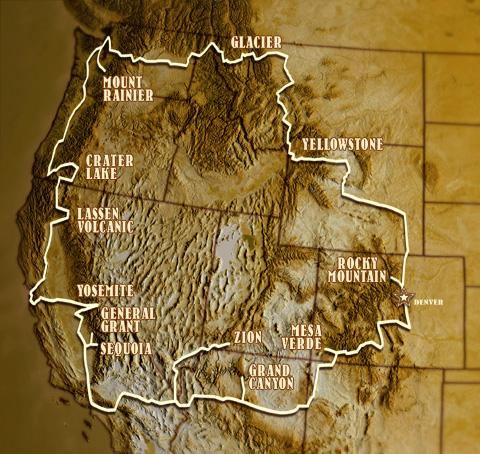In the early 1900s, some national parks existed, but getting to them was problematic. Then was born the idea -- with the help of Stephen Mather, the first director of the National Park Service -- to develop a "National Park-to-Park Highway," one that would run through 11 states and connect 13 national parks.
It was a bold, even audacious, plan, as there were no paved roads, no gas stations, no mechanics. Those who were first to navigate it had no one to rely on but themselves, and so they had to be sure they hauled plenty of tools, parts, and fuel.
The route was one huge loop, leading from Denver to Rocky Mountain National Park, through Wyoming to Yellowstone, north through Montana to Glacier National Park, then west to Mount Rainier, south to Crater Lake, Lassen Volcanic, Yosemite, General Grant and Sequoia national parks, then east to Zion, Grand Canyon, Petrified Forest, Mesa Verde, and back to Denver. Definitely not a weekend road trip.
While you can now travel paved highways to all these parks, and no doubt make better time than those early road warriors did, getting a glimpse of the development of the National Park-to-Park Highway is not easily accomplished without a time machine.
Fortunately, someone made a documentary about it. That would be director Brandon Wade who, with a strong, but small, supporting cast created Paving the Way, the National Park-to-Park Highway.
On the clear, cloudless morning of August 26th, 1920, in the city of Denver, Colorado, twelve American motorists set out on a 5,000 mile, 76-day pilgrimage to all twelve National Parks. This Park-to-Park Highway was the longest motor route to date—and its roads were not even paved.
PAVING THE WAY: The National Park-to-Park Highway begins with a brief history of the automobile, from its status as a rich man’s toy to its remarkable affordability with the invention of Henry Ford’s assembly line. Once the average American is able to travel, civic movements such as “See America First” begin to promote tourism within the National Parks, shifting from the railroad to the automobile. The decimation of World War I and the flu pandemic of 1918 hindered this movement, but by 1920, the American public was ready to get out and explore the West.
However, roads for automobiles were crude at best. There were no reliable maps, gas stations, or convenience stores. Accommodations were few, far between, and expensive. Because of this, the newly established National Park Service decided to promote both tourism to the National Parks and the good roads to get there with the National Park-to-Park Highway.
Two characters played major roles in organizing the inaugural tour of this highway. Stephen Mather, the director of the National Park Service, was the major advocate for the highway linking the National Parks. However, Anton Westgard, a pathfinder for AAA, was the one who mapped the route through the parks and led the motorists on the tour. One provided the idea, the other provided the manpower.
You can learn more about the production, and buy a copy, from this website. In the meantime, here's the trailer:
PAVING THE WAY: The National Park-to-Park Highway - HD Trailer from Brandon Wade on Vimeo.




Comments
I watched this documentary recently on PBS and it was very interesting to learn about how few roads existed especially in National Parks. It was also interesting how the idea for this "highway" took shape and the people who made it a reality. If you are interested in the western National Parks at all this is a must see!
Within the past few years I've been fortunate enough to drive some of these roads. Magnificent! See America First!
This documentary ran again yesterday afternoon and I was facinated by how so many wonderful things can happen with the insight of just a few people. The fun part of this program was trying to determine which of the roads I traveled to see the parks were part of the ones they were paving anew. If you have not had the opportunity to go west and see the wonders of our national parks it should be placed at the top of your to do list, they are Magnificent!!
I watched all week the special on PBS about the National Parks it was wonderful. American is so beautiful, I thank everyone that made the shows, the past presidents that made the National parks happen. It is a great place to take children, grandchildren just to sit and be amazed at all what God has created. John Meir how he traveled by foot to see all these wonderful places before cars and all the visitor centers roads were build is so unbelievable. We don't have go far to see so of the most beautiful places in the world, they are here in American.
My wife and I are thinking of driving this same route in a six-week road trip this fall. Has anyone else tried this? Would it be possible to link in all the newer national parks on the same trip?
Is there a current map of this trip? is it possible to re-drive this tour? i would love to take some time and do it.
My husband and I have just watched the PBS documentary and would love to drive this route. We feel it would an awesome experience.
My husband and I just watched the documentary. Having lived out there in
Colorado and only visiting the Rocky Mountain Nt'l park, we would love
to take the road trip and explore the whole loop. We feel it would be an
awesome adventure. Anyone wanna set up an organized caravan?????